Assessment of the Reliability of Wind Farm Device on the Basis of Modeling Its Operation Process
Abstract
1. Introduction
- Assessment of the Operation Process of Wind Power Plant’s Equipment with the Use of an Artificial Neural Network. Energies, 2020, 13, 2437;
- Reliability Testing of Wind Power Plant Devices with the Use of an Intelligent Diagnostic System. Energies 2022, 15, 3583.
- Assessment of the Reliability of Wind Farm Devices in the Operation Process. Energies 2022, 15, 3860.
- Organization and Reliability Testing of Wind Farm Device in its Operation Process. Energies 2022, 15, 6255.
- -
- Model A: an operation process of a wind power plant that uses an intelligent maintenance system with an artificial neural network.
- -
- Model B: an operation process of the object that uses information in bivalent logic: a model with a maintenance system organized by planning its optimal prevention activities.
- -
- Model C: an operation process of a wind power plant with a maintenance system that is classically organized without any examination of the state in the assessment process: a strategy for the maintenance of the object with the period of prevention activities being planned.
- The regeneration of the object in the designed intelligent maintenance system that uses the information from an artificial neural network;
- A traditional manner of the organization of the maintenance system (model C);
- Defined strategies of prevention activities in relation to the quality of the operation process;
- An assessment of the quality of the operation process of the wind power plant with a traditional method of the organization of the maintenance system;
- The conducting of a qualitative assessment of the strategies adopted to maintain the fitness of the WPP for the quality of the operation process.
- -
- Model A: the process by which intelligent systems in wind farm equipment assist in making decisions about the safety of their use (the model with the operating system with WPPES and an artificial neural network);
- -
- Model B: Wind farm equipment without intelligent systems to support decisions on how safely to operate it (operating system model with WPPES and artificial neural network);
- -
- Model C: Basic equipment operation procedure for wind farms.
- Testing and Evaluation of the Reliability of Wind Farm Devices in the Operation Process Due to the Decrease in the Value of the Repair Time.
- Testing and Evaluation of the Reliability of Wind Farm Devices in the Operation Process Due to Changes in the Value of Time between Successive Failures of Wind Farm Devices.
Review of the Literature
- -
- X(ei,j) represents whether the diagnostic signal is the j-th element of the i-th set;
- -
- X(w)(ei,j) is a benchmark signal. For X(ei,j);
- -
- FC the minimum or maximum product use feature value;
- -
- {ME(ei,j)} IS the knowledge foundation for customer service;
- -
- {ME} is the system for upgrading technical infrastructure;
- -
- W(ε(ei,j) = {3, 2, 1, 0}) Item information value for the diagnostic state assessment logic ”j” within the ”i” object module.
2. Assessment of the Operation Process of Wind Power Plant’s Equipment with the Use of an Artificial Neural Network
Using Data from an Artificial Neural Network, the Planned Intelligent Maintenance System Will Let Objects Grow New Parts
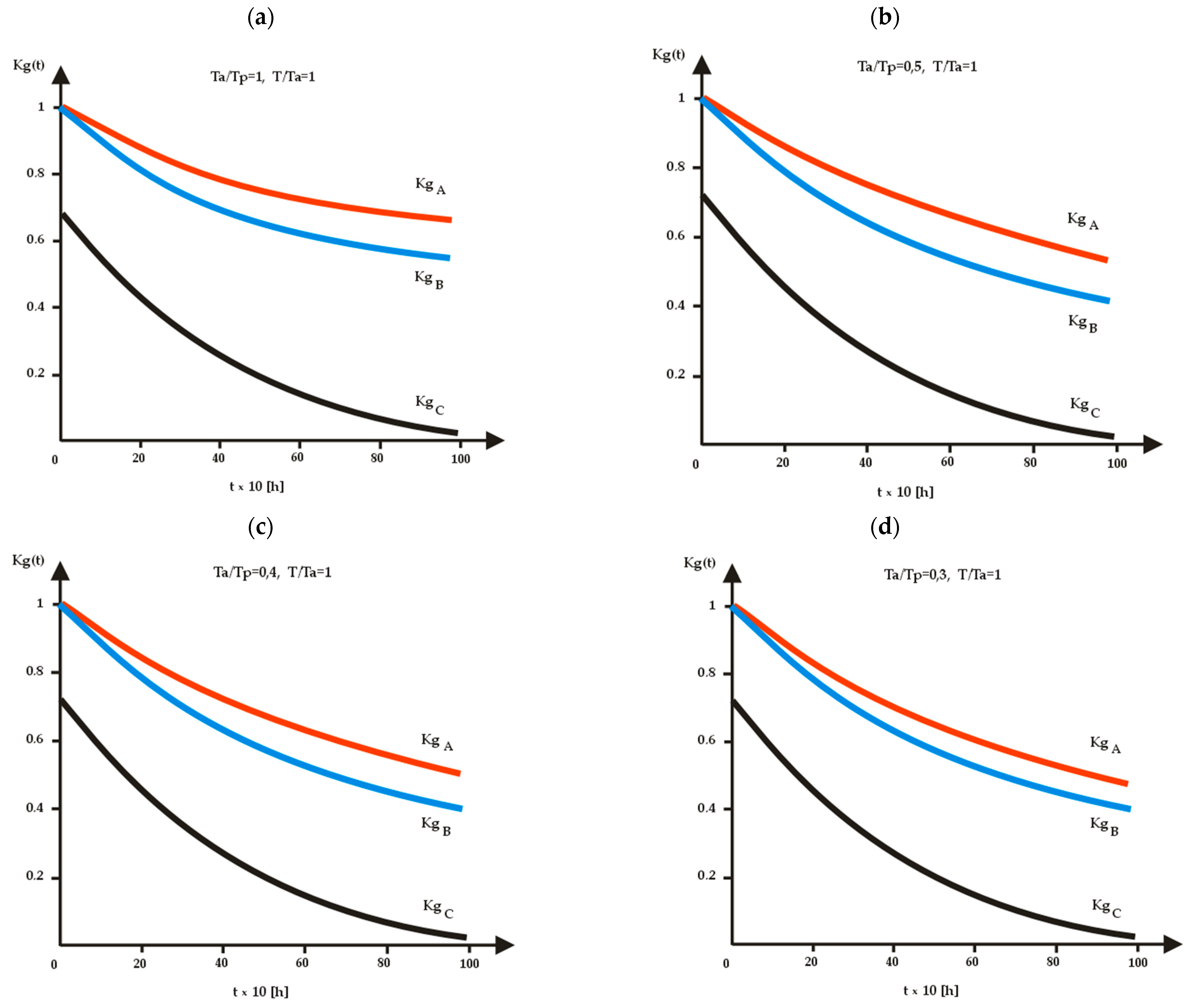
3. Reliability Testing of Wind Power Plant Devices with the Use of an Intelligent Diagnostic System
Assessment of the Reliability of Wind Farm Equipment on the Basis of the Readiness Function
- Models (A, B, and C) depict how the wind farm’s machinery operates.
- A test strategy is created.
- Preparation: information is entered about the tested object’s functionality, such as its use time (T), working life (TNA), time to remove unfitness (TNP), and planned repair time (TNP).
- The operation process (use and maintenance) of the wind farm equipment is understood and described.
- Model (A, B, and C) coefficient (Kg) value. The value tested in the model is (KgA = 0.7508). On the other hand, this value is as follows for the remaining models: KgC is equal to 0.2332 and KgB = 0.4931, respectively. The arrangement of the utilization of wind farm equipment in the operational process in Model (A) is therefore the most effective system.
- The purpose of wind farm equipment’s operational process quality (FC) in models A, B, and C). The model (A), where FCA = 0.2239, has the highest standard of equipment utilization in the operation of a wind farm (FC). For models B and C, these values, which add up to (FCB = 0.1979 and FCC = 0.0959), are, however, lower.
- Equipment in wind farms that is unreliable during operation (Fch). This is the highest number (FchC = 0.9750) that was considered for model C. This value (FchA = 0.7508) for model A is the smallest value. Additionally, we can draw the conclusion that the equipment set for the Wind Farm is capable of operating during the analyzed operational period (t = T) for time (t = 3/4T) in model C.
4. Assessment of the Reliability of Wind Farm Devices in the Operational Process
Using the Availability Factor as a Basis for Reliability Analysis of Wind Farm Equipment
- -
- Model A, reporting the functioning of wind power projects with intelligent decision-supporting systems;
- -
- Model B, explaining how to run wind farm equipment that does not have smart support systems or use the WPPES system
- -
- Model C, describing a straightforward (ideal) procedure for running the equipment at a wind farm.
5. Organization and Reliability Testing of Wind Farm Device in Its Operation Process
Testing of Wind Power Plant Equipment Reliability during Operation
- The first step involved looking at the reliability function (Ro(t)) of the WFD in use.
- The second part of the WFD simulation study was the time-flow current (t51) of the WFD’s residency in the state (S5) during the important technological activity of renewing the WFD.
6. Conclusions
- Using data from an artificial neural network, in which the planned intelligent maintenance system will let objects grow new parts,
- Assessment of the reliability of wind farm equipment on the basis of the readiness function,
- Using the availability factor as a basis for reliability analysis of wind farm equipment,
- Testing of wind power plant equipment reliability during operation.
Author Contributions
Funding
Informed Consent Statement
Data Availability Statement
Conflicts of Interest
Symbols and Initialisms
| X (ei,j) | diagnostic signal in the jth element of the ith set, |
| X(w) (ei,j) | model signal for X (ei,j) signal, |
| FC max | max. value of the function of the use of the object, |
| W (ε(ei,j)) = {2, 1, 0}) | valued of state assessment logics for jth element within ith module (from the set of the accepted three-value logic of states’ assessment) |
| probability function for a WFD system in the state of full fitness S1 | |
| probability function for a WFD system in the state of partial fitness S2 | |
| probability function for a WFD system in the state of partial fitness S3 | |
| probability function for a WFD system in the state of partial unfitness S4 | |
| probability function for a WFD system in the state of full unfitness S5 | |
| λ | damage intensity |
| To | simulation test time of the object |
| μ | repair intensity |
| λ1 | intensity of type I inspections |
| μ1 | type I operational maintenance intensity |
| λ2 | intensity of type II inspections |
| μ2 | type II operational maintenance intensity |
| {ME(ei,j)} | service knowledge base |
| {ME} | technical facility renovation system |
| WFD | wind farm device |
| WPPES | Wind Power Plant Expert System |
| SERV | intelligent operating system |
| DIAG | intelligent diagnostic system |
References
- Duer, S. Assessment of the Operation Process of Wind Power Plant’s Equipment with the Use of an Artificial Neural Network. Energies 2020, 13, 2437. [Google Scholar] [CrossRef]
- Duer, S.; Paś, J.; Stawowy, M.; Hapka, A.; Duer, R.; Ostrowski, A.; Woźniak, M. Reliability Testing of Wind Power Plant Devices with the Use of an Intelligent Diagnostic System. Energies 2022, 15, 3583. [Google Scholar] [CrossRef]
- Duer, S.; Paś, J.; Hapka, A.; Duer, R.; Ostrowski, A.; Woźniak, M. Assessment of the Reliability of Wind Farm Devices in the Operation Process. Energies 2022, 15, 3860. [Google Scholar] [CrossRef]
- Duer, S.; Rokosz, K.; Bernatowicz, D.; Ostrowski, A.; Woźniak, M.; Zajkowski, K.; Iqbal, A. Organization and Reliability Testing of Wind Farm Device in its Operation Process. Energies 2022, 15, 6255. [Google Scholar] [CrossRef]
- Rychlicki, M.; Kasprzyk, Z.; Rosiński, A. Analysis of Accuracy and Reliability of Different Types of GPS Receivers. Sensors 2020, 20, 6498. [Google Scholar] [CrossRef]
- Bedkowski, L.; Dabrowski, T. Basic of the Maintenance Theory p. 2; Publishing House of WAT: Warsaw, Poland, 2006; p. 187. [Google Scholar]
- Epstein, B.; Weissman, I. Mathematical Models for Systems Reliability; CRC Press/Taylor & Francis Group: Boca Raton, FL, USA, 2008. [Google Scholar]
- Linz, P. An Introduction to Formal Languages and Automata; University of California: Davis, CA, USA, 2002. [Google Scholar]
- Abo-Khalil, A.G.; Alghamdi, A.I.; Tlili, A.; Eltamaly, A.M. Current Controller Design for DFIG-based Wind Turbines Using State Feedback Control. IET Renew. Power Gener. 2019, 13, 1938–1949. [Google Scholar] [CrossRef]
- Eltamaly, A.M. Modeling of wind turbine driving permanent magnet generator with maximum power point tracking system. J. King Saud Univ.-Eng. Sci. 2007, 19, 223–236. [Google Scholar] [CrossRef]
- Andalib, C.; Liang, X.; Zhang, H. Fuzzy-Secondary-Controller-Based Virtual Synchronous Generator Control Scheme for Interfacing Inverters of Renewable Distributed Generation in Microgrids. IEEE Trans. Ind. Appl. 2018, 54, 1047–1061. [Google Scholar] [CrossRef]
- Stawowy, M.; Rosinski, A.; Pas, J.; Klimczak, T. Method of Estimating Uncertainty as a Way to Evaluate Continuity Quality of Power Supply in Hospital Devices. Energies 2021, 14, 486. [Google Scholar] [CrossRef]
- Stawowy, M.; Olchowik, W.; Rosiński, A.; Dąbrowski, T. The Analysis and Modelling of the Quality of Information Acquired from Weather Station Sensors. Remote Sens. 2021, 13, 693. [Google Scholar] [CrossRef]
- Paś, J.; Rosiński, A.; Chrzan, M.; Białek, K. Reliability-Operational Analysis of the LED Lighting Module Including Electromagnetic Interference. IEEE Trans. Electromagn. Compact. 2020, 62, 2747–2758. [Google Scholar] [CrossRef]
- Kunjumuhammed, L.P.; Pal, B.C.; Oates, C.; Dyke, K.L. Electrical oscillations in wind farm systems: Analysis and insight based on detailed modeling. IEEE Trans. Sustain. Energy 2016, 7, 51–62. [Google Scholar] [CrossRef]
- Shahanaghi, K.; Babaei, H.; Bakhsha, A. A Chance Constrained Model for a Two Units Series Critical System Suffering From Continuous Deterioration. Int. J. Ind. Eng. Prod. Res. 2009, 20, 69–75. [Google Scholar]
- Mathirajan, M.; Chandru, V.; Sivakumar, A.I. Heuristic algorithms for scheduling heat-treatment furnaces of steel casting industries. Sadhana 2007, 32, 111–119. [Google Scholar] [CrossRef]
- Krzykowski, M.; Pas, J.; Rosinski, A. Assessment of the level of reliability of power supplies of the objects of critical Infrastructure. IOP Conf. Ser. Earth Environ. Sci. 2019, 214, 012018. [Google Scholar] [CrossRef]
- Dhillon, B.S. Applied Reliability and Quality, Fundamentals, Methods, and Procedures; Springer: London, UK, 2006; p. 186. [Google Scholar]
- Kacalak, W.; Majewski, M. New Intelligent Interactive Automated Systems for Design of Machine Elements and Assemblies. In Lecture Notes in Computer Science; Springer: Berlin/Heidelberg, Germany, 2012; Part IV; Volume 7666, pp. 115–122. [Google Scholar]
- Lipinski, D.; Majewski, M. System for Monitoring and Optimization of Micro- and Nano-Machining Processes Using Intelligent Voice and Visual Communication. In Lecture Notes in Computer Science; Springer: Berlin/Heidelberg, Germany, 2013; Volume 8206, pp. 16–23. [Google Scholar]
- Majewski, M.; Kacalak, W. Smart Control of Lifting Devices Using Patterns and Antipatterns. Advances in Intelligent Systems and Computing. In Artificial Intelligence Trends in Intelligent Systems; Springer: Cham, Switzerland, 2017; Volume 573, pp. 486–493. [Google Scholar] [CrossRef]
- Majewski, M.; Kacalak, W. Innovative Intelligent Interaction Systems of Loader Cranes and Their Human Operators. Advances in Intelligent Systems and Computing. In Artificial Intelligence Trends in Intelligent Systems; Springer: Cham, Switzerland, 2017; Volume 573, pp. 474–485. [Google Scholar] [CrossRef]
- Paś, J.; Rosiński, A.; Wiśnios, M.; Stawowy, M. Assessing the Operation System of Fire Alarm System for Detection Line and Circuit Devices with Various Damage Intensities. Energies 2022, 15, 3066. [Google Scholar] [CrossRef]
- Dyduch, J.; Paś, J.; Rosiński, A. The Basic of the Exploitation of Transport Electronic Systems; Publishing House of Radom University of Technology: Radom, Poland, 2011. [Google Scholar]
- Siergiejczyk, M.; Paś, J.; Rosiński, A. Issue of reliability–exploitation evaluation of electronic transport systems used in the railway environment with consideration of electromagnetic interference. IET Intell. Transp. Syst. 2016, 10, 587–593. [Google Scholar] [CrossRef]
- Łukasiak, J.; Rosiński, A.; Wiśnios, M. The Issue of Evaluating the Effectiveness of Miniature Safety Fuses as Anti-Damage Systems. Energies 2022, 15, 4013. [Google Scholar] [CrossRef]
- Wang, H.; Ma, K.; Blaabjerg, F. Design for reliability of power electronic systems. In Proceedings of the IECON 2012—38th Annual Conference on IEEE Industrial Electronics Society, Montreal, QC, Canada, 25–28 October 2012; pp. 33–44. [Google Scholar] [CrossRef]
- Ma, K.; Yang, Y.; Wang, H.; Blaabjerg, F. Design for Reliability of Power Electronics in Renewable Energy Systems. In Green Energy and Technology; Springer: Cham, Switzerland, 2014; pp. 295–338. [Google Scholar]
- Siergiejczyk, M.; Rosiński, A. Analysis of power supply maintenance in transport telematics system. Solid State Phenom. 2014, 210, 14–19. [Google Scholar] [CrossRef]
- Nakagawa, T. Maintenance Theory of Reliability; Springer: London, UK, 2005. [Google Scholar]
- Nakagawa, T.; Ito, K. Optimal inspection policies for a storage system with degradation at periodic tests. Math. Comput. Model. 2000, 31, 191–195. [Google Scholar]
- Badrzadeh, B.; Gupta, M.; Singh, N.; Petersson, A.; Max, L.; Høgdahl, M. Power system harmonic analysis in wind power plants-Part I: Study methodology and techniques. In Proceedings of the IEEE Industry Applications Society Annual Meeting, Las Vegas, NV, USA, 7–11 October 2012; pp. 1–11. [Google Scholar]
- Pogaku, N.; Prodanovic, M.; Green, T.C. Modeling, analysis and testing of autonomous operation of an inverter-based microgrid. IEEE Trans. Power Electron. 2007, 22, 613–625. [Google Scholar] [CrossRef]
- Chung, I.-H. Exploring the Influence of the Parameters’ Relationship between Reliability and Maintainability for Offshore Wind Farm Engineering. Energies 2022, 15, 5610. [Google Scholar] [CrossRef]
- Tavner, P.J.; Xiang, J.; Spinato, F. Reliability analysis for wind turbines. Wind Energy 2007, 10, 1–18. [Google Scholar] [CrossRef]
- Pokoradi, L. Logical Tree of Mathematical Modeling. Theory Appl. Math. Comput. Sci. 2015, 5, 20–28. [Google Scholar]
- Dempster, A.P. Upper and lower probabilities induced by a multi-valued mapping. Ann. Math. Stat. 1967, 38, 325–339. [Google Scholar] [CrossRef]
- Buchannan, B.; Shortliffe, E. Rule-Based Expert Systems; Addison—Wesley Publishing Company: London, UK; Amsterdam, The Netherlands; Don Mills, ON, Canada; Sydney, Australia, 1985; p. 387. [Google Scholar]

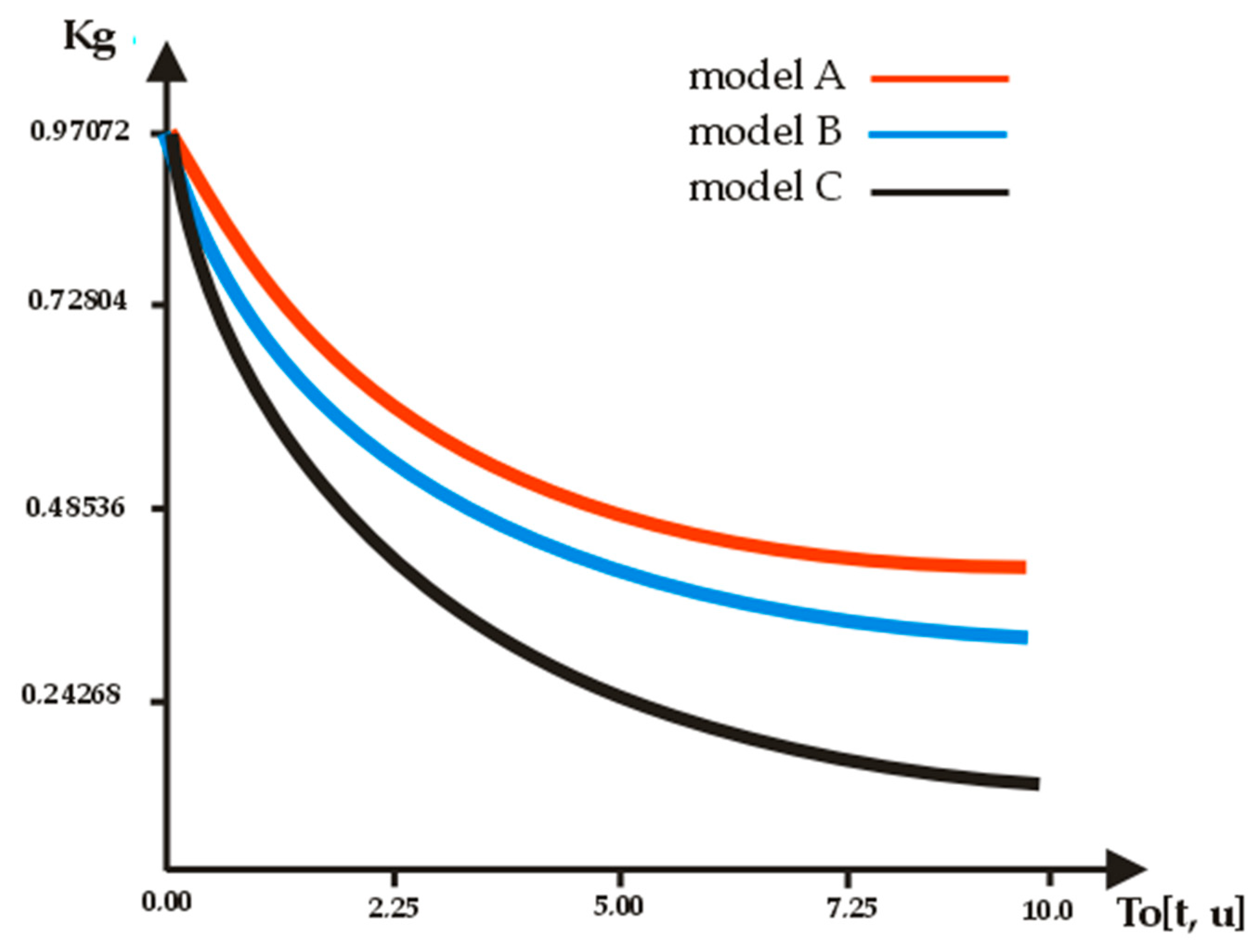

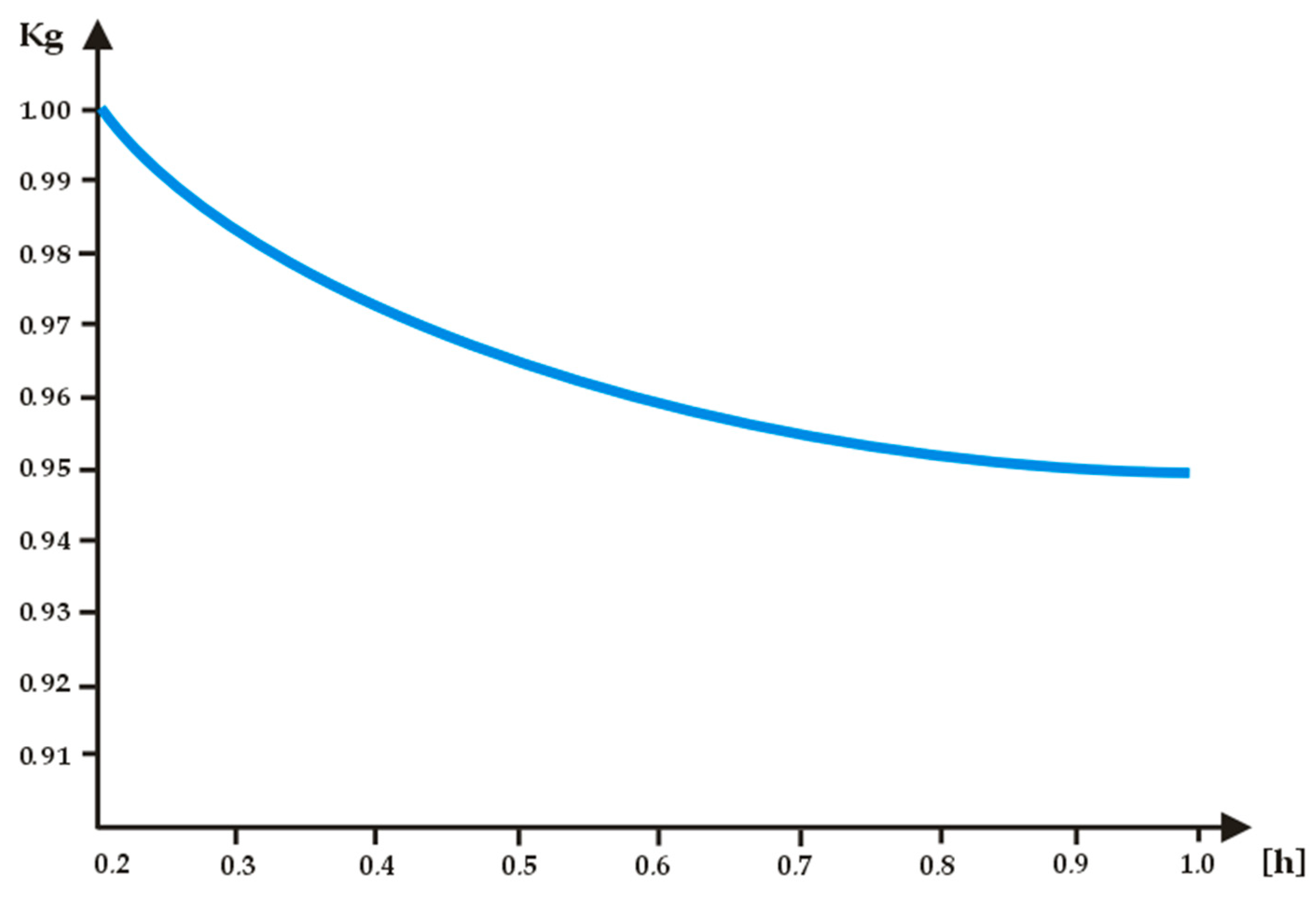
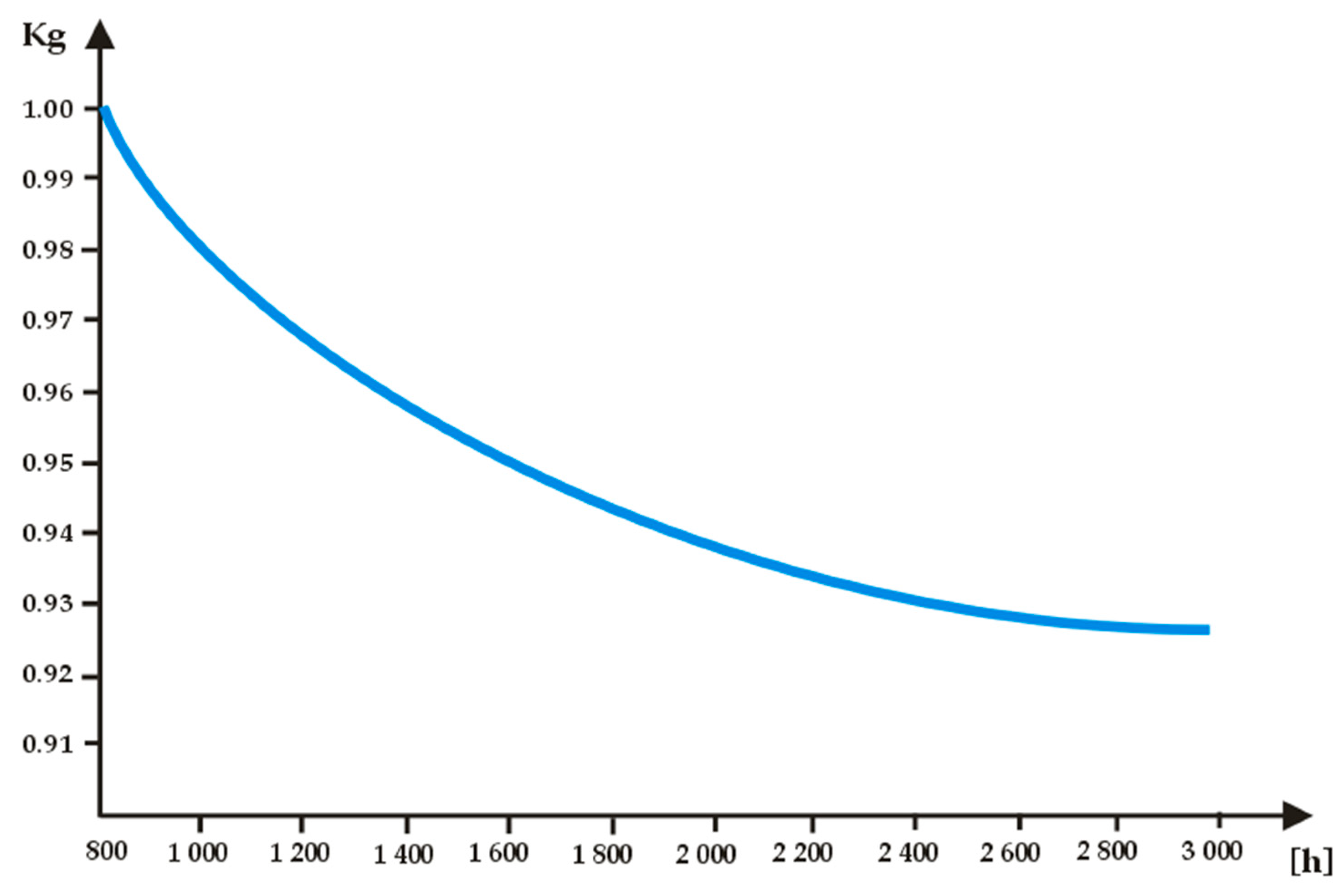
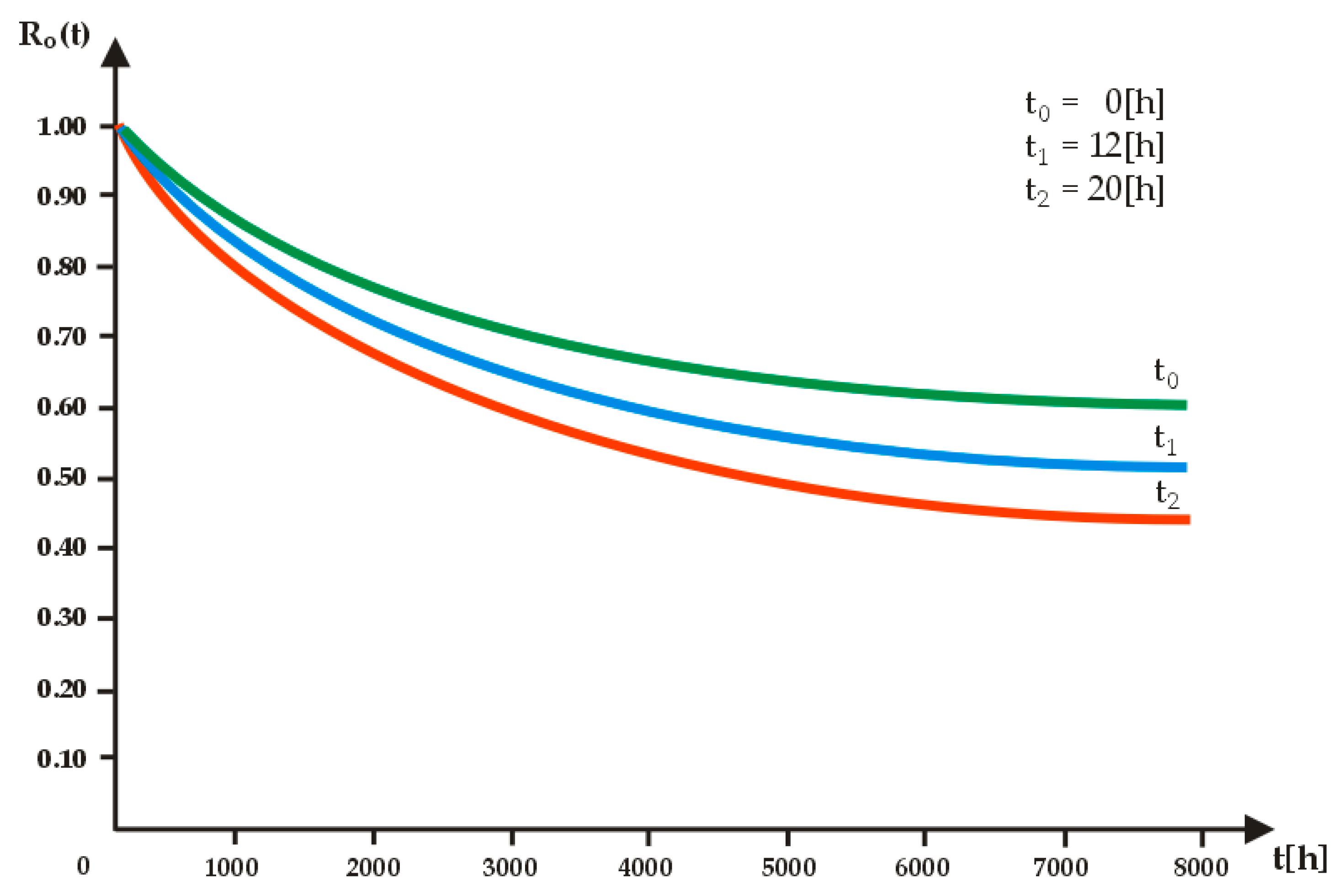
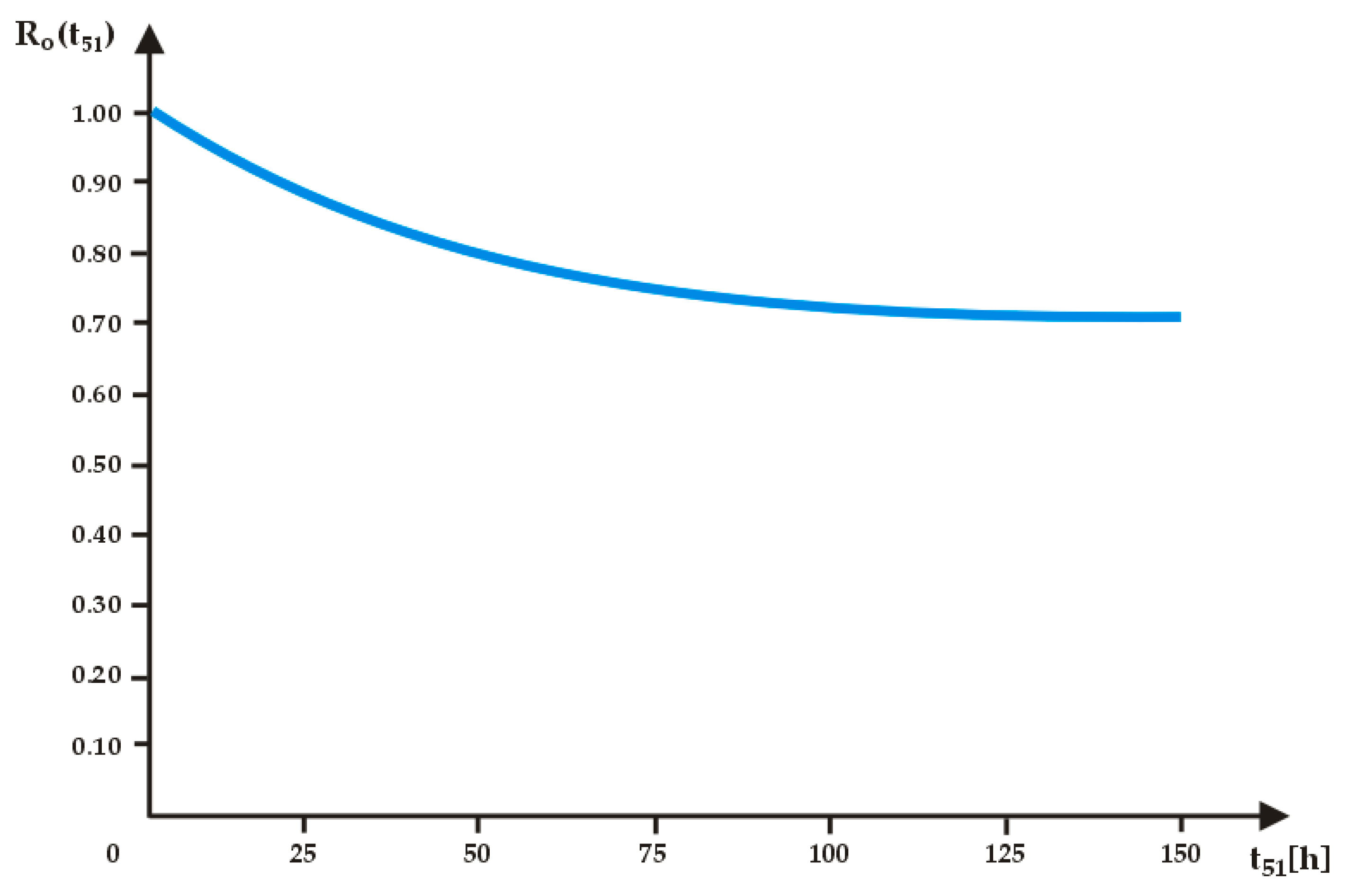
Disclaimer/Publisher’s Note: The statements, opinions and data contained in all publications are solely those of the individual author(s) and contributor(s) and not of MDPI and/or the editor(s). MDPI and/or the editor(s) disclaim responsibility for any injury to people or property resulting from any ideas, methods, instructions or products referred to in the content. |
© 2022 by the authors. Licensee MDPI, Basel, Switzerland. This article is an open access article distributed under the terms and conditions of the Creative Commons Attribution (CC BY) license (https://creativecommons.org/licenses/by/4.0/).
Share and Cite
Duer, S.; Woźniak, M.; Ostrowski, A.; Paś, J.; Duer, R.; Zajkowski, K.; Bernatowicz, D. Assessment of the Reliability of Wind Farm Device on the Basis of Modeling Its Operation Process. Energies 2023, 16, 142. https://doi.org/10.3390/en16010142
Duer S, Woźniak M, Ostrowski A, Paś J, Duer R, Zajkowski K, Bernatowicz D. Assessment of the Reliability of Wind Farm Device on the Basis of Modeling Its Operation Process. Energies. 2023; 16(1):142. https://doi.org/10.3390/en16010142
Chicago/Turabian StyleDuer, Stanisław, Marek Woźniak, Arkadiusz Ostrowski, Jacek Paś, Radosław Duer, Konrad Zajkowski, and Dariusz Bernatowicz. 2023. "Assessment of the Reliability of Wind Farm Device on the Basis of Modeling Its Operation Process" Energies 16, no. 1: 142. https://doi.org/10.3390/en16010142
APA StyleDuer, S., Woźniak, M., Ostrowski, A., Paś, J., Duer, R., Zajkowski, K., & Bernatowicz, D. (2023). Assessment of the Reliability of Wind Farm Device on the Basis of Modeling Its Operation Process. Energies, 16(1), 142. https://doi.org/10.3390/en16010142








